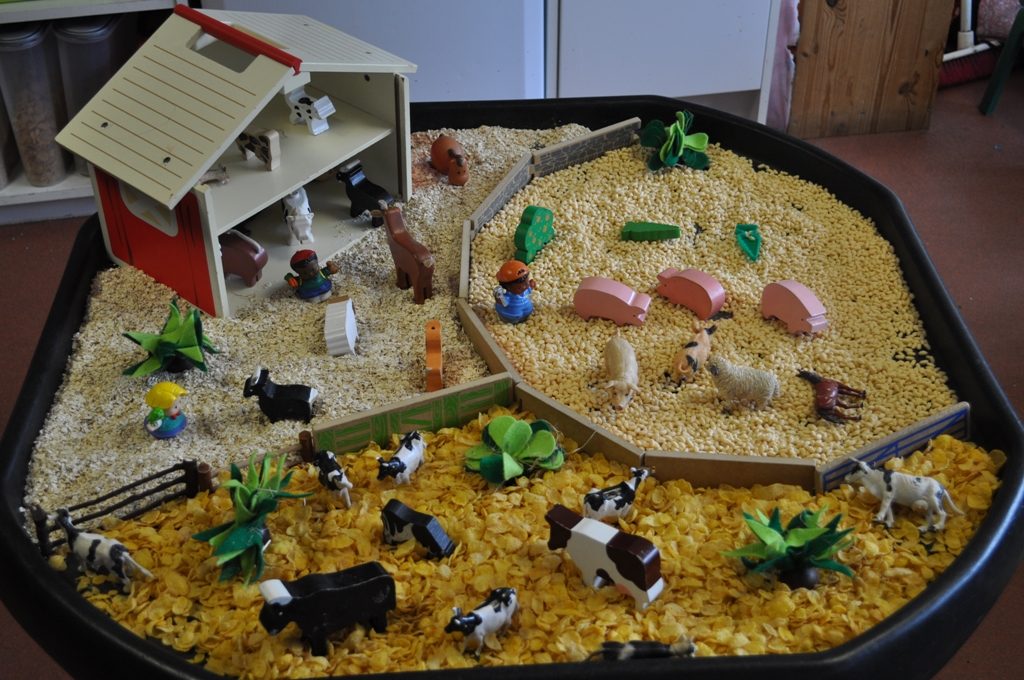There are endless ways to use a Tuff spot, here are some fun ideas to extend the children’s sensory experience.
Tuff spots are a great way for all children to explore a range of activities and materials at a low level. Babies and preschool aged children can explore resources in the tray by lying or sitting on the floor to access the tray. Check out 10 great ways to use a #tuffspot.
1.Food play
Using different types of food in the Tuff spot allows children to feel different textures. Baked beans, cooked spaghetti and mashed potato allow the children to experiment with different materials and experiment with mixing them together. Adding utensils enables the children who do not enjoy messy play to take part in the activity, whilst supporting their learning in using tools.
2.Sensory play
Why not support the children in making their own gloop. Mix the ingredients in the large #tuffspot tray and then let the children explore the texture of the gloop. There are many other sensory play ideas you could do using a tuff spot tray. Visit our Pinterest page for more ideas
3.Dinosaur world
Creating a small world area using your Tuff spot supports children’s imagination. Create mounds of earth using compost and pockets of water, adding sticks and leaves from the outside area to create a dinosaur swamp. Children will love stomping the small world dinosaurs through the different areas of the swamp and creating scenarios.
4.Building structures
This is a great idea for children that love building and creating structures. Add lots of different sized wooden blocks to the tray alongside some wet sand and spades. Allow the children to use the wet sand as cement to piece the blocks together and create buildings and structures. This will support the children’s creative development and their problem solving skills.
5.Ice cube play
Freeze some Arctic small world animals in a bowl of water and leave on the Tuff spot alongside some tools. Allow the children to chip away at the ice blocks to discover the hidden animals. The children will enjoy trying to melt the ice to see who is hiding whilst developing their problem solving skills. Another great activty is to provide children will different colours of paint and let them paint the ice cubes.
6.“We’re going on a bear hunt”
Tuff spots are a great way to extend children’s experience by recreating a favourite story. “We’re going on a bear hunt” can be recreated using a number of tuff spots by offering different parts of the story in each one. Water, mud, green tissue paper, wooden bark and shaving foam can offer a range of textures for the child to experience whilst on their bear hunt. The children can walk through each #tuffspot, talking about how the different areas feel on their hands and their feet.
7.Three little pigs
To support this story through the use of a Tuff spot, different materials for the houses in the story can be offered alongside small world pigs. Lolly pop sticks, straw and wooden bricks are useful materials to use. Ask the children to build a house for the three pigs using each of the materials. Straws can then be introduced for the children to play the wolf, solving which house cannot be blown down. How to extend this story further
8.Milk experiment
This is a great way for children to experience some basic science, using milk and food colouring. Fill the bottom of the Tuff spot with milk and add blobs of food colouring, using different colours. Finally add a small amount of washing up liquid, watching the colours spread out and make fun patterns. The children can dip cotton beds in the washing up liquid and make patterns in the milk.
9.Sorting
Add a range of small, hard materials such as pulses, pasta and rice to the Tuff spot and mix them together. Then offer some small sorting bowls and chunky tweezers, allowing the children to sort the materials into the bowls using the tweezers. This activity will support children’s fine motor skills alongside their hand eye coordination.
10.Farmyard
Using different types of dry food play why not create a farmyard scene. The different foods could represent the areas in which the animals live. Include a farm building, animals and small world people to bring the imagination alive.
Please follow us on Facebook for more Early Years News

